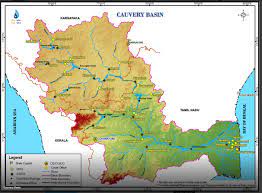01 Oct Cauvery River Water Dispute GS- 1 InterState Relations, Water Resources, Dispute Redressal Mechanism, Co-operative Federalism, Tribunals
CONTEXT
Recently, the Cauvery Water Management Authority (CWMA) directed Karnataka to immediately release the balance quantum of water to Tamil Nadu. However, CWMA dropped discussion on the Mekedatu reservoir project following a “strong protest” from Tamil Nadu, Kerala, and Puducherry.
About River Cauvery
-
It is known as ‘Ponni’ in Tamil, also known as Ganga of the south, and it is the fourth largest river of southern India.
-
It is a sacred river of southern India.
-
It rises on Brahmagiri Hill of the Western Ghats in southwestern Karnataka state, flows in a southeasterly direction through the states of Karnataka and Tamil Nadu, and descends the Eastern Ghats in a series of great falls and drains into the Bay of Bengal through Pondicherry.
-
Some of its tributaries are Arkavathi, Hemavathi, Lakshmana Theertha, Shimsa, Kabini, and Harangi.
About Cauvery Water Dispute.
It involves 3 states and one Union Territory (Tamil Nadu, Kerala, Karnataka, and Puducherry). The genesis of the dispute is 150 years old and dates back to the two agreements of arbitration in 1892 and 1924 between the then Madras Presidency and Mysore. It entailed the principle that the upper riparian state must obtain the consent of the lower riparian state for any construction activity viz. reservoir on the river Cauvery.
From 1974, Karnataka started diverting water into its four newly made reservoirs, without the consent of Tamil Nadu resulting in a dispute. To resolve the matter, the CWDT (Cauvery Water Disputes Tribunal) was established in 1990 which took 17 years to arrive at the final order (2007) on how Cauvery water should be shared between the 4 riparian states in normal rainfall conditions. CWDT was constituted by the Central Government, in the exercise of the powers conferred by section 4 of the Inter-State River Water Disputes Act, 1956.
In distress years, a pro-rata basis shall be used, it instructed. The government again took 6 years and notified the order in 2013. This was challenged in SC (Supreme Court) which directed Karnataka to release 12000 cusecs of water to Tamil Nadu prompting protests in the State. The final verdict of the SC came in 2018 where it declared the Cauvery a national asset and largely upheld the water-sharing arrangements finalized by the CWDT and also reduced the allocation of water from Karnataka to Tamil Nadu.






No Comments